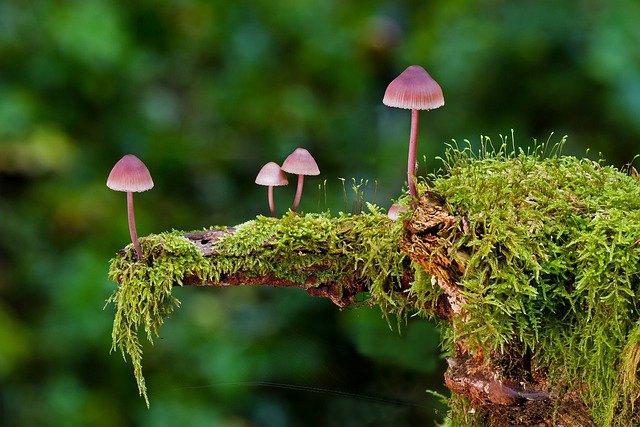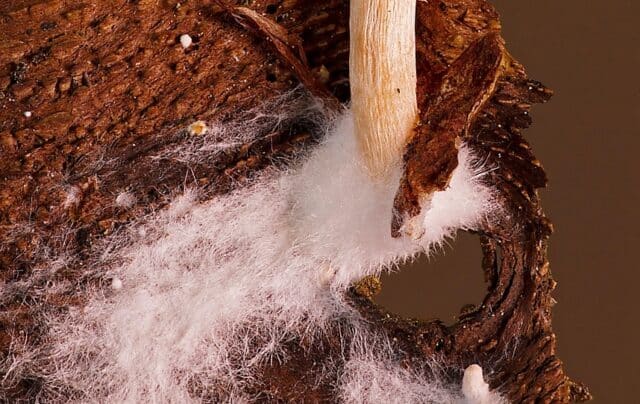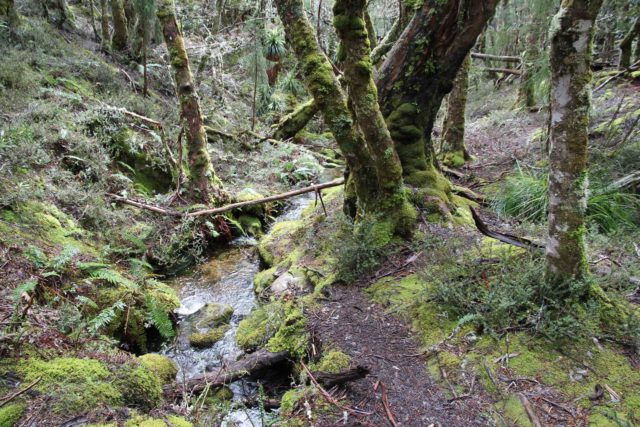Most people don’t spend a lot of time thinking about fungus. If you’re not using mushrooms in your dinner, and you’re not cleaning up mold somewhere, it’s probably not big on your list of priorities unless you’re stress watching The Last of Us. But there’s a lot more to fungus than most of us realize. In fact, it’s a lot more fungus than most of us realize.
Head to Oregon’s Malheur National Forest and you’ll find little Armillaria ostoyae mushrooms popping up here and there through the trees. But they’re not individuals; they’re all connected underground and are growing from the same organism. One that covers 3.5 square miles.
The part of the mushroom that we’re used to seeing, the part we eat in edible mushrooms, is only used for reproductive purposes. The rest of the fungus lives underground as a mycelial network, sort of like a root system that connects all of these fruiting bodies together.
In this particular giant fungus, this network attaches itself to the root systems of trees and devours them. That’s how it sustains itself. And it’s done this in the same spot for 10,000 years. In other words, a mycelial network is incredibly efficient. And they do a heck of a lot more than just eat roots. After all, if you’d been around for 10,000 years, you’d probably learn a few tricks, too.
What are Mycelial Networks?

A mycelial network is a fungus; it can get very big, and it’s underground, eating trees. What else? The mycelium are fine, hair-like threads that weave together underground. They look almost like a loose-knit blanket weave in some species, depending on how densely they are packed together. But it’s not that easy to see it all. Some of these individual “roots” are thinner than a human hair.
Known as hyphae, these thin filaments can be just two micrometers in diameter, while a hair is a positively girthy 17 micrometers. As they branch out in all directions, they make more connections than a human brain.
Over 100 miles of mycelium can be packed into just over 2 pounds of soil. This is how they form a mycelial network, which is the vast structure of threads, or even a mycorrhizal network, which is slightly different.
A mycorrhizal network is a mycelial network that is symbiotic between fungi and other plants, like trees. Unlike our big friend in Oregon, which eats the roots and kills the trees, fungi that form a mycorrhizal network help the trees they connect with.
How does all this work? The fungus can draw nutrients from dead matter and soil since fungus can feed on almost anything. It will transfer these nutrients to the tree roots and, in exchange, get some of the tree’s photosynthate, the energy it derives from the sun, which is something the fungus can’t do on its own. As much as 30% of the sugars produced by photosynthesis will go to the fungus in this way.
In human terms, imagine a tree as your friend who loves tacos, and you as a fungus who loves pizza. You both have a good meal alone on Friday night, but if you hang out, you both get to have tacos and pizza, and isn’t that better for everyone? The answer is yes.
Water, nitrogen, carbon, and all sorts of other minerals that are, admittedly, less delicious than tacos and pizza, are shared between the organisms to the benefit of all. It has been theorized that the fungus is mostly rewarded with carbon from the trees, and the trees get phosphorus and other minerals.
What makes it a network is that the mycelium doesn’t just latch on to one tree. As with the giant in the forest in Oregon, these can spread to many trees, connecting each one to allow them to share nutrients and keep a whole grove, a whole forest, thriving. This is especially helpful when some trees, like saplings, are hidden from sunlight or located in a place where water is more scarce.
Fungal Brains

We said a little earlier that a mycelial network forms more connections than a human brain. That’s not the only way fungus has been likened to a human mind. Research has shown that these networks have a sort of memory and also decision-making abilities. This information seems almost unbelievable at first, but we have plenty of evidence that other organisms like octopus and crows possess remarkable intelligence, so why not an organism that is so vastly complex?
In experiments, the hyphae in a network have demonstrated spatial awareness. They will alter how they develop based on interactions with other organisms. Fungus has been shown to remember stressful experiences for up to 12 hours and avoid where and how it happened.
If a wood block is placed in the soil with mycelium as bait, a source of nutrients, and then moved, the remaining mycelium will continue to grow to where the block used to be, indicating that the larger organism remembers where it once was.
When networks are allowed to grow, they do so in ways that preserve resources and limit stress. Their growth patterns indicate that the whole network is connected and communicating so that the entire organism “understands” what is best for it. Or, in other words, it functions like neurons in a brain.
The functioning of these hyphae has been measured with microelectrodes and has shown that membrane polarization and depolarization occur across the hyphal membranes, and it resembles nerve impulses in animals. The function in fungus, however, is still unknown, but it may even be related to language.
Research into these electrical impulses shows that, at least in some forms of fungus, the electrical signals resemble a simple language. The signals increase when the network discovers a food source, for instance.
Recordings of the electrical impulses were searched for patterns, and it was discovered that similar spikes occurred in similar situations, or trains of activity. In fact, the team was able to discern about 50 words throughout these activity trains that were, on average, about 5.97 letters long. English averages about 4.8 letters per word.
The researcher behind the observations was quick to point out that this may be a simple way for the network to identify food sources and things that it wants to stay away from. And it’s just as likely this is not a form of communication at all. However, whatever the impulses are for, they are not generated randomly, so they do serve a purpose.
The mycorrhizal network allows linked organisms to share warnings among themselves. Tomato plants infected with a disease called early blight were able to transmit this information to uninfected plants nearby, which allowed them to start producing a defensive enzyme to ward off the disease. Stress signals were transmitted through the mycelium, and the healthy plants received and reacted to them.
Biology professor Nicholas Money proposed the idea that fungal networks possess what he called a “minimal selfhood.” They don’t have intelligence at the level of a human mind by any means. The network is not nearly as complex as a brain, but it is complex nonetheless, and fungus shows a sort of rudimentary consciousness defined by its ability to maintain itself and reproduce.
Whatever information that a mycelial network can convey, there’s definitely something happening, and it’s not just with the fungus. It’s with the other organisms that they connect.
Unique Mycelial Capabilities

People have long held that plants and music have a relationship, but this is typically related to things like houseplants and the idea that certain kinds of music make them grow better. There isn’t a lot of conclusive scientific data to support that, although there is some that suggests certain vibrations can either help or hinder the growth of plants. Fungus, as it happens, operates similarly.
Fungus can convert sound waves into electrical signals. This can help in fungal growth as well as development. The electrical pulses were measured and converted back into sound by the Octopus Project, a group of musically inclined scientists, which allowed them to record what is essentially music played by mushrooms. You can find some samples of it online where mushrooms like shiitake and others have been recorded.
As interesting as it is that fungus may respond to sound and even produce its own, there are greater implications. If the sound promotes growth, then it’s been theorized that every plant in the mycorrhizal network could benefit. That means you could potentially increase crop yields just by playing the right sounds.
Hearing isn’t the only unusual thing that mycelium can do. They can also eat things that can’t normally be eaten, like radiation. We covered how a mycorrhizal network can potentially benefit both fungus and tree life by sharing nutrients back and forth. This is because there are certain nutrients that fungi don’t make on their own, or don’t make nearly as efficiently as other plants do.
The same theory applies to fungi when it comes to radiation. Certain kinds of fungus, in places like Chernobyl, have adapted to feed on radiation. Just like a tree converts sunlight into energy through photosynthesis, or you turn your tacos and pizza into energy by consuming the calories via digestion and metabolism, these fungi absorb gamma radiation and turn it into energy.
Research into using radio-adaptive fungus to not only clean up radioactive zones but also detect secret nuclear facilities has been proposed.
Mushrooms have long been known for radiation resistance. In one study, mice that were fed black mushrooms exhibited higher than normal protection from external radiation. So eating mushrooms, dark ones that contain melanin, could literally protect soldiers and others exposed to dangerous radiation. Something to think about the next time you’re worried about some X-rays.
Tree Connections

Mycelium is integral to forest health. Fungus is able to break down organic matter and ensure soil stays healthy for other organisms to grow by returning nutrients as part of the carbon cycle. They are also crucial to some other plant reproduction, like orchids, for instance. If a very specific fungus is not present in the roots of these orchids, they cannot reproduce at all, making this the most dire form of symbiosis. The plant and the fungus literally need each other to survive.
Some other species of plants, like pinesap, have evolved to no longer rely on photosynthesis but have the fungus connecting them to provide the energy they need to survive. In fact, over 90% of all plant life relies on a symbiotic mycorrhizal network of some kind. If it weren’t for fungus, our world would look vastly different.
The idea that these networks connect and benefit trees and other plants has been proposed and observed by many naturalists, doctors, ecologists, and foresters.
Is it All Real?

Not everyone agrees with this concept of a “wood wide web” and the overall influence or benefits of a mycorrhizal network. Dr. Justine Karst, an expert in ectomycorrhizal ecology, believes there’s more fiction than fact in what these networks can do, at least in terms of what has been reported. Karst has contested claims that the networks benefit connected trees and seedlings, citing a lack of any real hard evidence.
Also suspect in Karst’s view is the idea that mycorrhizal networks are as widespread as has been suggested. Too few forests have been mapped to make this conclusion, and only two studies have even suggested the existence of a network without enough data to support a beneficial symbiosis theory.
Karst went on to challenge the idea, which we mentioned earlier, that the networks bring nutrients to all the linked trees, including saplings. In fact, there’s as much evidence that being connected to a network would harm these seedlings as benefit them.
A third claim, which relates to the one regarding tomatoes from earlier, suggests that trees can send warning signals through the network to let other trees know of a dangerous insect infestation, allowing uninfected trees to start producing defensive enzymes. And while that sounds amazing, Karst says that claim has never been backed by a single peer-reviewed, published study.
Karst is not dismissing the idea that these networks exist or that they may have benefits, just that we shouldn’t be so quick to believe everything we read when all the evidence to support it isn’t necessarily there. And besides, there is plenty of evidence for many of the remarkable things we know about mycelial networks, and certainly enough to encourage people to want to research more deeply and find out the truth about these complex organisms.